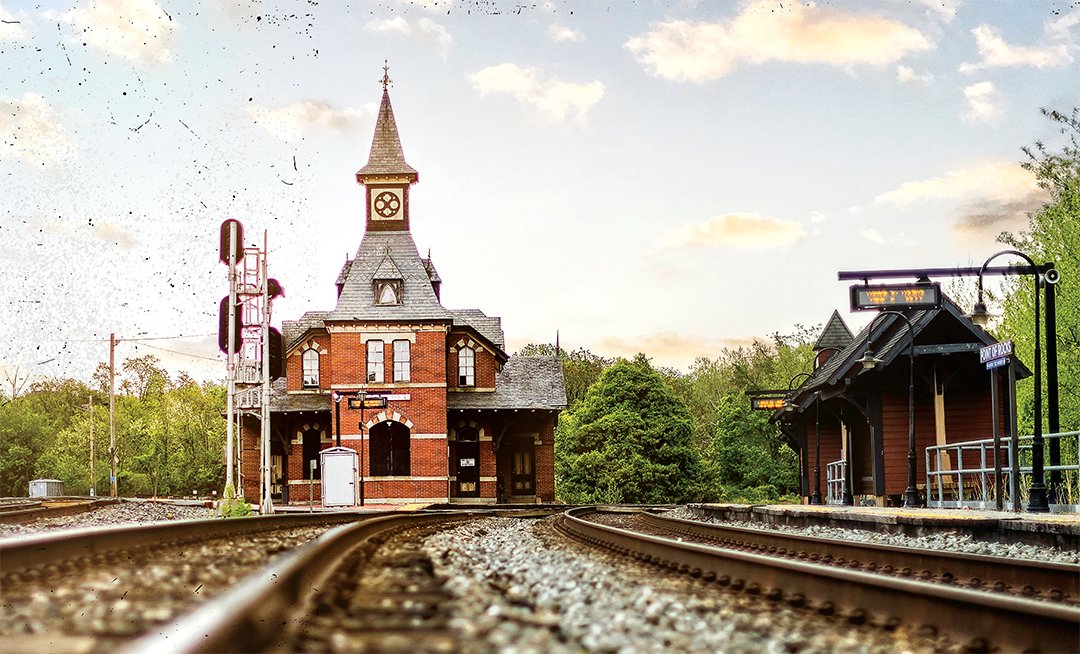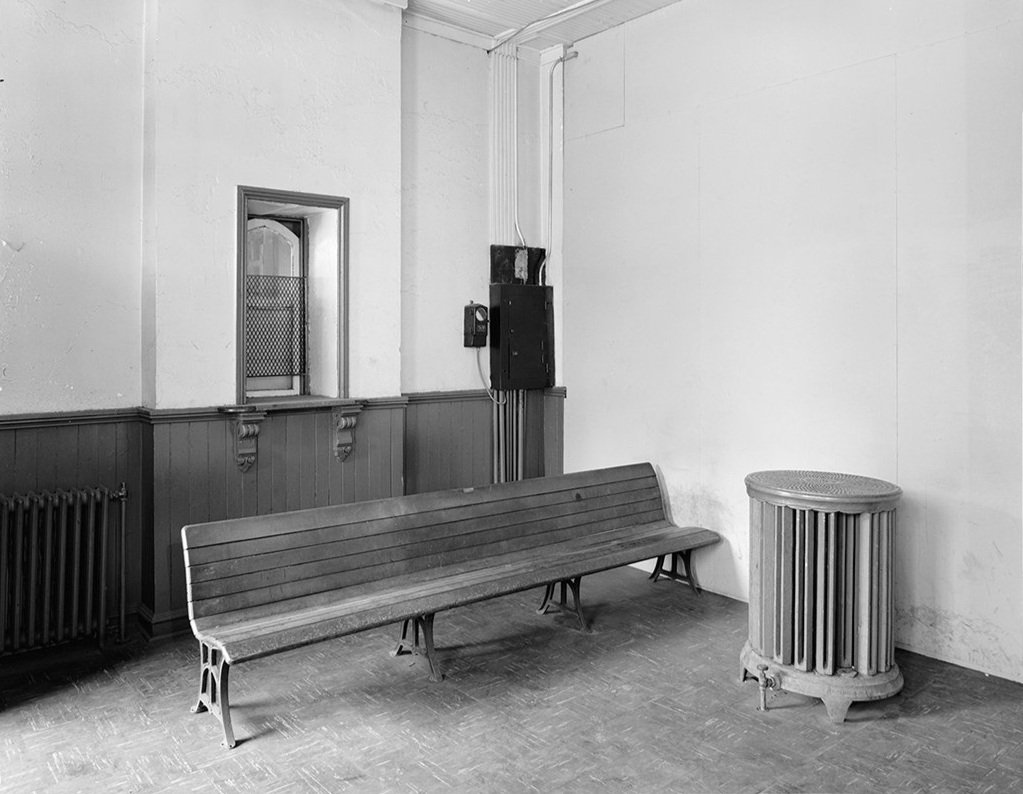Sidetracked
POINT OF ROCKS STATION REFLECTS VICTORIAN AGE, REVEALS UNCERTAIN FUTURE
By Guy Fletcher
With its brick walls, gothic windows and prominent steeple, the historic Point of Rocks Station could almost be confused for a country church were it not shouldered by railroad tracks. It only makes sense, since the man who designed the 19th-century building also created many churches from his drafting table.
But make no mistake, Point of Rocks is all train station—evoking wistful images of Edwardian-dressed passengers and the shriek of a train’s whistle accompanied by an enthusiastic conductor belting, “All aboard!”
A similar image filled the head of 9-year-old Pepper Scotto when she first saw the station in 1955. Her family was moving from Prince George’s County to a farm near Jefferson and her father wanted to make a quick stop before reaching their new home.
“That was my introduction to the Point of Rocks Station,” she says, staring today at a structure that maintains an elegant veneer despite its obvious need of repair. “… I was actually impressed at 9.” She still is.
The iconic station is now being commemorated by the U.S. Postal Service with its own postage stamp. The “Railroad Stations Forever” series highlights five buildings that celebrate the history, nostalgia and romance of train travel.
Selecting Point of Rocks Station for such an honor makes perfect sense, says Scotto, who might qualify as the building’s biggest cheerleader. Yes, she concedes, there are countless other historic train stations, many of them quite lovely, that would look very nice on a stamp.
But?
“They don’t compare,” she says with a smile.
Five miles up the tracks in Brunswick, visitors to the Brunswick Heritage Museum come from all over the country and beyond to see the 1,700-square-foot HO-scale reproduction of the region’s rail system. The trains and interactive displays dazzle the guests, but there is one highlight that sticks out.
“People point to that building,” James Castle, president of the museum, says of a model of Point of Rocks Station. “They recognize it.”
Nonetheless, the station’s charm and celebrity camouflage deeper concerns about its future. The building stands boarded up today, having gone mostly unused for decades, and no one is quite sure what its future role will be. Some worry the station is simply being left unprotected to the elements and will eventually collapse or be destroyed.
“It makes you uneasy,” says Castle. “How long can it last without maintenance?”
ANCHOR OF ATTENTION
The Point of Rocks Station was designed in the early 1870s by E. Francis Baldwin, chief architect for the Baltimore and Ohio Railroad. Baldwin was responsible for some of the railroad’s most famous structures, including the mammoth B&O Warehouse that looms above Oriole Park at Camden Yards. His work can also be seen in other surviving stations, most of which followed the popular Queen Anne style of the day.
But the ornate Point of Rocks Station, which opened in 1875, was Baldwin’s masterpiece, and where his appreciation for the railroad might have been influenced by another passion: religion. Baldwin’s portfolio included many churches, seminaries, schools and other facilities for the Roman Catholic Church. He was so highly regarded that he received a medal from Pope Leo XIII for his work on buildings at the Catholic University of America.
Visitors to the church-like Point of Rocks Station often note the building’s detailed architectural style as simply “Victorian,” but the Gothic Revival touches are all there—the dormer windows, lancet-shaped windows and clay chimney pots. The station is “unusually sophisticated for its rural setting and ranks with the most outstanding work of the Victorian Gothic Revival [period],” according to a 1972 report from the Maryland Historical Trust.
But the hallmark of Baldwin’s design is its location. Point of Rocks once marked the confluence of one of the busiest railroad junctions in the nation, where the B&O Main line from Baltimore met the Metropolitan Branch originating in Washington, D.C. Here, railroad tracks arriving from nearly opposite directions merged for passengers and freight traveling to western destinations and back.
To accommodate this convergence, Baldwin wedged his station between the Baltimore and D.C. tracks, not beside them. The positioning created a striking image—the four-story tower/steeple rising above the tracks and trees, with dual passenger platforms extending on either side.
“The station,” Scotto says, “is something of an anchor of attention.”
For more than a century this image has been captured and re-created in paintings, photographs, model railroads and other media. A Google search for the station reveals a seemingly endless offering of images from all perspectives, angles and seasons of the year, making it arguably the most photographed location in Frederick County, but even more. “It’s the most photographed train station in America,” Scotto says.
The U.S. Postal Service focused on Point of Rocks Station during its original research for “Railroad Stations Forever” as the design team sought stations with architectural and geographic diversity, desiring to include smaller stations in smaller towns, says Mark Wahl, USPS spokesman. “We also wanted the stations to be ones that people could go and visit. As we began working on the stamp designs, the team further narrowed its focus to historic stations, and ended up with five stations listed on the National Register of Historic Places.”
POINT OF ROCKS IS THE HUB
The middle of the 20th century saw the emergence of automobiles and the introduction of the Interstate highway system, a combination punch that devastated the passenger railroad industry following World War II. Between 1945 and 1964, non-commuter rail passenger travel in the United States declined by a mammoth 84 percent.
Point of Rocks Station closed in 1962, although trains continued to stop at the location to take on and drop off passengers. In 1971, Congress consolidated the country’s long-distance passenger lines into the National Railroad Passenger Corp., or Amtrak, and Point of Rocks became a commuter stop only, served by the B&O until the Maryland Area Regional Commuter (MARC) rail line took over in the mid-1980s.
The station was placed on the National Register of Historic Places in 1973, but now only serves as storage for CSX Transportation, the B&O successor whose freight trains continue to rumble through Point of Rocks along with MARC and Amtrak trains. MARC passengers board from a simple platform across the tracks.
Resurrection of the station was a key part of a plan first put together more than a decade ago by the Frederick Area Committee on Transportation (FACT), an advocacy group for the expansion of local commuter service in the City of Frederick. FACT proposed improvements at the Point of Rocks Station to allow boarding from city-bound trains—currently not available—that would enhance flexibility and make Frederick a main line instead of a spur.
The plan would have made Point of Rocks “a keystone station” and included the renovation of the building, adding restrooms and a waiting area for commuters, says Jonathan Warner, a FACT member. “Point of Rocks is the hub of everything,” Warner reasons.
MARC, meanwhile, proposed preserving and restoring the station in its most recent commuter rail expansion study, but also acknowledged hurdles, such as environmental requirements and securing an undetermined financial commitment from CSX.
The Maryland Transportation Authority (MTA), the division of the state Department of Transportation that operates MARC, completed a structural assessment of the building, “but discussions about the facility and its potential role in the MARC system are still in the exploratory stage,” says spokesman Paul Shepard.
“We are evaluating the public feedback received in response to the Brunswick Line Study Technical Report and continuing discussions with CSX about enhancing Brunswick Line service, including at Point of Rocks,” he adds.
CSX, meanwhile, issued a brief statement about Point of Rocks: “MARC/MTA has expressed an interest in acquiring the rights to use the station and we have been cooperating with the agency to advance the project.”
Any effort to save, preserve or enhance the station would likely require an investment of millions of dollars. In addition to CSX and MARC, potential funders could include other government sources or private donors and foundations.
Scotto, who helped raise money for the restoration of the nearby Catoctin Aqueduct on the C&O Canal, is confident the money can be found for such a worthy endeavor. “We raised $2 million for an aqueduct and nobody knows what an aqueduct is,” she says.
THE DANGER
Today, the major features from the station’s romantic past remain and it’s still easy for visitors to imagine its former glory, but the luster is worn. Bricks and beams are damaged in places and many windows have been broken and replaced by black plywood panels. And that’s just what can be seen from the outside.
“There is nobody from the railroad working inside,” says Scotto, “which is the danger.”
With no one in the building, there could be water damage or some other structural threat that could lead to its walls crumbling and possibly tumbling onto the tracks. Then the building could disrupt rail service or be deemed a public hazard, making it ripe for demolition. The irony is the station’s aesthetic hallmark of being so close to the tracks could also be its undoing.
Scotto worries it is possible she could visit the site one day and the station could be gone. But she chooses her words diplomatically and says she is not about “saving” the station, but rather an advocate for “enhancing and appreciating the work CSX has done to preserve” the building.
Just as she refuses to criticize CSX, Scotto resists speculating about how the building could be transformed, perhaps into a museum or some other cultural site. But she allows that maybe the station could be refurbished to allow overnight stays, like the old lockhouses on the canal.
“There are people who would pay their firstborn child to spend the night in the second-floor quarters,” she says, pointing at the station.
Castle, the Brunswick museum president, appreciates Scotto’s reluctance to speak candidly about the station and its preservation. He recalls the public effort three decades ago to save the historic Brunswick Roundhouse—also owned by CSX—that abruptly ended with its demolition.
“There is a history of complaining about things and then having them go away,” Castle says.
So, for now, the station sits. Train buffs from out of town will often stop by to take their photos. Scotto recalls meeting a couple of railroad retirees from Baltimore who set up lawn chairs next to the tracks just to watch the trains chug by for hours. Others report similar scenes, with visitors anxiously asking about Point of Rocks’ status.
The station remains an anchor of attention.






